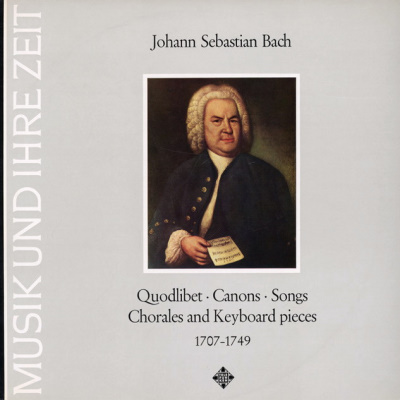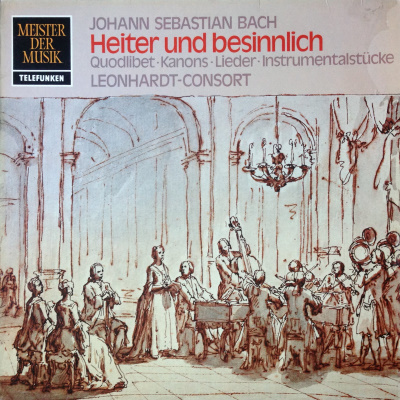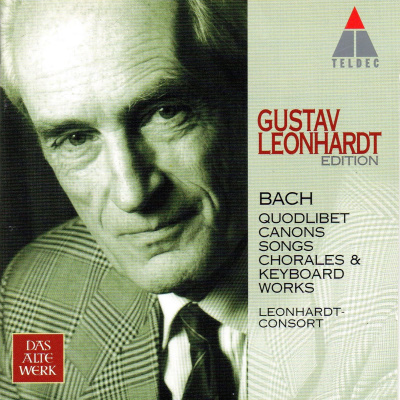 |
|
1 LP -
SAWT 9457-B - (p) 1964
|
 |
| 1 LP -
6.42091 AN - (p) 1964 |
 |
| 1 CD -
3984-21354-2 - (c) 1998 |
|
| QUODLIBET -
KANONS - LIEDER - INSTRUMENTALSTÜCKE |
|
|
|
|
|
|
|
| Johann Sebastian
BACH (1685-1750) |
Präludium
F-dur, BWV 927 - aus: Neun kleine
Präludien, aus dem Klavierbüchlein für
Wilhelm Friedemann Bach, Köthen 1720/21
|
|
0' 40" |
A1 |
|
Quodlibet
(Fragment) für vier Singstimmen mit
Generalbaß, BWV 524 - wahrscheinlich
1707, Mülhausen |
|
9' 30" |
A2 |
|
Präludium
E-dur, BWV 937 - aus: Neun kleine
Präludien, aus dem Klavierbüchlein für
Wilhelm Friedemann Bach, Köthen 1720/21 |
|
1' 23" |
A3
|
|
Präludium g-moll, BWV 929 -
aus: Neun kleine Präludien, aus dem
Klavierbüchlein für Wilhelm Friedemann
Bach, Köthen 1720/21 |
|
1' 00" |
A4
|
|
So
oft ich meine Tobacks-Pfeife, BWV
515a - Erbauliche Gedanken eines
Tobackrauchers aus dem Klavier-büchlein
für Anna Magdalena Bach, 1725 |
|
3' 12" |
A5 |
|
Präludium
d-moll, BWV 940 - aus: Neun kleine
Präludien, aus dem Klavierbüchlein für
Wilhelm Friedemann Bach, Köthen 1720/21 |
|
0' 47" |
A6 |
|
Kanon
zu 2 Stimmen, BWV 1075 - "Canon a 2.
perpetuus", Leipzig, 1734 |
|
1' 05" |
A7 |
|
Kanon
zu sieben (acht) Stimmen, BWV 1078 -
"fa mi, et Mi fa est tota Musica",
Leipzig, 1749 |
|
0' 35" |
A8 |
|
Präludium
D-dur, BWV 925 - aus: Neun kleine
Präludien, aus dem Klavierbüchlein für
Wilhelm Friedemann Bach, Köthen 1720/21 |
|
1' 15" |
A9 |
|
Gib
dich zufrieden und sei stille, BWV
511 - aus dem: Klavierbüchlein für Anna
Magdalena Bach, 1725 |
|
4' 10" |
A10 |
|
Kanon
zu vier Stimmen, BWV 1073 - "Canon a
4. Voc: perpetuus", Weimar 1713 |
|
1' 15" |
B1 |
|
Kanon
zu drei (fünf) Stimmen, BWV 1077 -
"Canone doppio sopr'il Soggetto", Leipzig
1747 |
|
1' 10" |
B2 |
|
O
Herzensangst, o Bongigkeit und Zagen,
BWV 400 - aus den "Chorälen für vier
Singstimmen" |
|
1' 40" |
B3 |
|
Nicht
so traurig, nicht so sehr, BWV 384 -
aus den "Chorälen für vier Singstimmen" |
|
2' 25" |
B4 |
|
Dir,
dir, Jehova, will ich singen, BWV
452 - aus dem: Klavierbüchlein für Anna
Magdalena Bach, 1725 |
|
2' 40" |
B5 |
|
Präludium
C-dur, BWV 939 - aus: Neun kleine
Präludien, aus dem Klavierbüchlein für
Wilhelm Friedemann Bach, Köthen 1720/21 |
|
0' 30" |
B6 |
|
Fuge
C-dur, BWV 952 - Köthen etwa 1720 |
|
2' 05" |
B7 |
|
Was
betrübst du dich, mein Herze, BWV
423 - aus den "Chorälen für vier
Singstimmen" |
|
3' 30" |
B8 |
|
Vergiß
mein nicht, mein allerliebster Gott,
BWV 505 - Schmellis Gesangbuch, Leipzig
1736 |
|
2' 00" |
B9 |
|
Wer
nur den lieben Gott läßt walten, BWV
691 (Choralbearb.) in
Kirnbergers Sammlung. Wahrscheinlich
Weimar 1708 bis 1717 |
|
1' 45" |
B10 |
|
Wer
nur den lieben Gott läßt walten, BWV
434 - aus den "Chorälen für vier
Singstimmen" |
|
2' 55" |
B11 |
|
Wer
nur den lieben Gott läßt walten, BWV
690 (Choralbearb.) in Kirnbergers
Sammlung. Wahrscheinlich Weimar 1708 bis
1717
|
|
1' 50" |
B12 |
|
|
|
|
|
Agnes
Giebel, Sopran
Marie Luise Gilles, Alt
Bert van t'Hoff, Tenor
Peter Christoph Runge, Baß
|
DAS
LEONHARDT-CONSORT
Gustav Leonhardt, Cembalo und
Orgel
Anner Bylsma, Violoncello
|
|
|
|
|
|
Luogo
e data di registrazione |
|
Haus Queekhoven,
Breukelen (Holland) - 12/20
Febbraio 1964
|
|
|
Registrazione:
live / studio |
|
studio |
|
|
Producer |
|
Wolf Erichson
|
|
|
Engineer |
|
Dieter Thomsen
|
|
|
Prima Edizione
LP |
|
Telefunken "Das Alte
Werk" | SAWT 9457-B (Stereo) - AWT
9457-C (Mono) | 1 LP - durata 47'
02" | (p) 1964 | ANA
Telefunken
"Meister der Musik" | SAWT
9457-B | 1 LP - durata 47' 02" |
(p) 1964 | ANA | Riedizione
|
|
|
Edizione CD |
|
Teldec Classics |
LC 6019 | 3984-21354-2 | 1 CD -
durata 73' 43" | (c) 1998 | ADD |
|
|
Cover
|
|
"Johann Sebastian
Bach", Ölgemälde von Elias
Gottlieb Haussmann.
|
|
|
Note |
|
-
|
|
|
|
|
|
Bach's “inner
biography”, his domestic and
artistic “day to day
existence”, are less known
to us than the private lives
of any other great composers
of the modern age. And yet
there are some works of his
- by no means few in number
- that are not very
pretentious and therefore
not very well known, but
which, in their very
modesty, are able to give us
clear information about the
composer's everyday life.
These are the little
practice pieces for the
domestic use of the musical
Bach family, the partly
serious, partly gay songs
and arias and the group of
compositions written for
special occasions or as
favours, which include both
the high-spirited Quodlibet
and the little but highly
complex instrumental canons
of the later years. The
wealth of forms and nuances
that Bach was able to impart
to these "little works",
their cpmbination of naive
charm, apparent casualness,
intimacy of private domestic
music-making or expert
contemplation of little
masterpieces of part-writing
and strictest formation into
the totality of a work of
art that is only outwardly
small and inconspicuous, are
movingly and astonishingly
manifested even in such a
limited selection as can be
accommodated of our record.
The “Little” Preludes -
altogether twenty have been
preserved for us - probably
all date from Bach's Köthen
period (1717-23), and have
partly come down to us in
the Little Keyboard Book for
Wilhelm Friedemann. They
were thus intended as simple
practice and study pieces
for the prospective keyboard
player and composer. In
Bach's hands they have
become real little works of
art, meticulously formulated
in spite of their outward
modesty and each with its
own clearly defined
character of expression
(quite apart from the fact
that each prelude, faithful
to its educational purpose,
presents its own problems of
fingering and articulation).
The little Fugue in C major,
BWV 952, almost certainly
belongs to the same
category; its authenticity,
however, has not been
completely established.
Also belonging to the
domestic circle of the Bach
family are the songs which
Bach himself and his second
wife Anna Magdalena wrote
down in the latter's second
“Notenbuch" (1725), although
these did not serve any
didactic purpose. They are
simple melodies with
continuo accompaniment,
which pour out their fervent
and tender expression
entirely from the intense
melodic writing of the voice
part, their harmony being
kept strikingly simple. (The
little “Aria’’ BWV 505 is
taken from the Schemelli
Song Book which was
published in 1736, but is
sure to have originated in
the same mode of music
making.) But the
twenty-four-year-old wife of
the Cantor of St. Thomas's
felt by no means only at
home in the world of
contemplative family
worship, as is shown by the
“cosy” humour of the Tobacco
Pipe Song, which also
provides evidence of the
fashion of "tobacco
intoxication" which had
taken a powerful hold of the
middle classes in Bach's
day.
Bach’s humour finds an even
more robust and unrestricted
expression than in the above
song in the fragmentary
Wedding Quodlibet. The
high-spirited text, in which
lines from various sources
are thrown together, abounds
in vigorous jokes and
allusions; the no less
high-spirited music is full
of folk song quotations and
musical jests. The whole
reflects the slightly
alcoholic revelry of a
proper wedding celebration
among citizens of the
baroque age, showing Bach
the “Cantor” from a most
unaccustomed but very
amiable side.
On the other hand, the
instrumental canons which
Bach wrote, mostly in the
latter years at Leipzig, in
family albums or dedicated
to his friends and patrons
on other occasions match
more closely the traditional
picture of the composer. The
way in which the ageing
master turned to profound
musical speculation,
demonstrated most
maggnificently in the Art of
Fugue and the Musical
Offering, also appears here
on a modest scale yet with
skillful and profound
results. The subtly
constructed little works,
which demand exact study and
enjoyment of every detail,
pass by almost too
fleetingly as an aural
experience.
Also austere and earnest in
character are finally the
four-part chorales, which
were first published after
Bach's death by C.P.E. Bach
and J.P. Kirnberger. In
their accurate and subtle
interpretation of the words
and their magnificent wealth
of harmony they stand, equal
in quality, alongside the
great chorale settings of
the cantatas; like the
latter, they combine the
simple chorale melodies
(those selected here all
being by Bach himself except
for BWV 434) in the soprano
with a fine web of lower
voices, the “voice of the
congregation” with its
individual interpretations,
to form a profound symbolic
unity. Turning to the purely
instrumental field, we find
this relationship finally
prevailing in the early
chorale arrangements for the
organ as well, which were
probably composed at Weimar
(1708-1717). The three last
pieces on our record - two
of these instrumental
chorale arrangements and one
vocal treatment of the same
chorale - clearly
demonstrate the basic
similarity as well as the
subtle differences between
these two different types of
performance and tone within
the same category.
|
  |
|
|